Current Account Statements: How to Read and Understand Your Bank Statement
April 15, 2025

Current account statements are essential financial documents that provide a detailed record of your business transactions. Understanding how to read these statements is crucial for effective financial management and accurate bookkeeping.
a) Anatomy of a Current Account Statement
A typical current account statement contains several key elements:
1. Account information
2. Statement period
3. Opening and closing balances
4. Transaction details
5. Summary of fees and charges
b) Decoding Transaction Details
The transaction section of your statement includes:
1. Date of each transaction
2. Description or narration of the transaction
3. Debit and credit amounts
4. Running balance after each transaction
c) Understanding Account Balance Types
Your statement may show different types of balances:
1. Available balance: Funds you can immediately access
2. Ledger balance: Total balance including pending transactions
3. Overdraft limit (if applicable)
d) Reconciling Your Statement
To ensure accuracy:
1. Compare your statement with your own financial records.
2. Check for any discrepancies or unfamiliar transactions.
3. Verify that all deposits and withdrawals are correctly recorded.
e) Analysing Your Financial Activity
Use your statement to gain insights into your business finances:
1. Track cash flow patterns.
2. Identify major income sources and expenses.
3. Monitor recurring charges and subscriptions.
f) Utilising Statement Information for Business Planning
Your account statement can help you:
1. Make informed budgeting decisions
2. Forecast future cash flow
3. Identify areas for cost reduction or revenue improvement
g) Digital Statement Features
Many banks now offer digital statements with additional features:
1. Searchable transactions
2. Categorized expenses
3. Downloadable data for accounting software integration
Final Thoughts
Mastering the art of reading your current account statement is essential for maintaining financial health and making informed business decisions. Regularly reviewing and analyzing your statements can provide valuable insights into your business's financial performance.
For businesses seeking user-friendly current account services with clear, comprehensive statements, Ujjivan Small Finance Bank offers digital banking solutions that provide easy-to-understand account statements and robust financial tracking tools to support your business growth.
FAQs
1. How often should I review my current account statement?
It's recommended to review your statement at least monthly. However, for businesses with high transaction volumes, weekly or even daily reviews can be beneficial for catching discrepancies early.
2. What should I do if I find an error on my current account statement?
Contact your bank immediately if you notice any discrepancies. Most banks have a specific timeframe for reporting errors, usually within 30-60 days of the statement date.
3. Can I get my current account statement in a specific format for my accounting software?
Many banks offer statements in various formats like CSV or OFX, which are compatible with accounting software. Check with your bank for available options and any associated fees.
Latest Blogs

Telangana Housing Board & KPHB Colony: A Guide to Affordable Urban Housing in Hyderabad
March 14, 2025
As Telangana continues its rapid urbanisation journey, two key housing entities—Telangana Housing Board (THB) and Kukatpally Housing Board Colony (KPHB)—have played critical roles in shaping the state's real estate ecosystem.

Does Checking CIBIL Score Frequently Lower Your Credit Points?
April 07, 2025
Imagine you're planning to apply for a home loan, a credit card, or even a car loan. Naturally, you want to ensure your CIBIL score is in good shape before proceeding.

Explained: Can NRIs Buy an Agricultural Land in India?
April 03, 2025
Real estate investment is often a top priority for Non-Resident Indians (NRIs) looking to retain strong financial ties to India.

How to Improve Your CIBIL Score from 600 to 750: A Step-by-Step Guide
April 02, 2025
Your CIBIL score is like your financial reputation—banks check it before approving loans or credit cards. If your score is hovering around 600, you might face difficulties in securing credit or may get loans with higher interest rates.

What Happens When You Leave Your Savings Account Unused?
April 01, 2025
Imagine waking up one day to find that your hard-earned money is locked away and inaccessible. Sounds stressful, right? This is precisely what happens when you leave your Savings Account inactive for too long.





